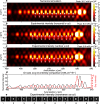Point singularity array with metasurfaces
- PMID: 37277345
- PMCID: PMC10241946
- DOI: 10.1038/s41467-023-39072-6
Point singularity array with metasurfaces
Abstract
Phase singularities are loci of darkness surrounded by monochromatic light in a scalar field, with applications in optical trapping, super-resolution imaging, and structured light-matter interactions. Although 1D singular structures, like optical vortices, are common due to their robust topological properties, uncommon 0D (point) and 2D (sheet) singularities can be generated by wavefront-shaping devices like metasurfaces. With the design flexibility of metasurfaces, we deterministically position ten identical point singularities using a single illumination source. The phasefront is inverse-designed using phase-gradient maximization with an automatically-differentiable propagator and produces tight longitudinal intensity confinement. The array is experimentally realized with a TiO2 metasurface. One possible application is blue-detuned neutral atom trap arrays, for which this field would enforce 3D confinement and a potential depth around 0.22 mK per watt of incident laser power. We show that metasurface-enabled point singularity engineering may significantly simplify and miniaturize the optical architecture for super-resolution microscopes and dark traps.
© 2023. The Author(s).
Conflict of interest statement
S.W.D.L., J.S.P., A.H.D, M.L.M., and F.C. are the inventors on a relevant provisional patent application (application number: US20230021549A1) owned by Harvard University. The authors declare no other competing interests.
Figures




References
-
- Dennis, M. R., O’Holleran, K. & Padgett, M. J. In Progress in Optics Vol. 53 (ed. Wolf, E.), 293–363 (Elsevier B.V., 2009).
-
- Gerchberg RW, Saxton W. Phase determination for image and diffraction plane pictures in the electron microscope. Optik. 1971;34:275–284.
-
- Gerchberg RW, Saxton WO. A practical algorithm for the determination of phase from image and diffraction plane pictures. Optik. 1972;35:237–246.
Grants and funding
LinkOut - more resources
Full Text Sources

